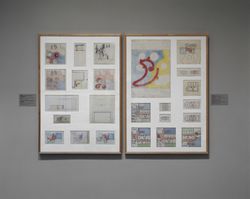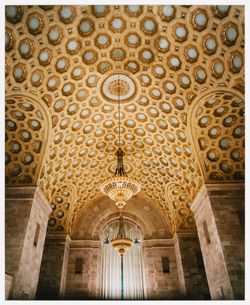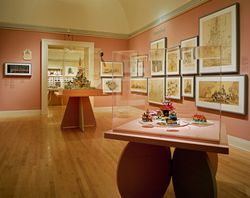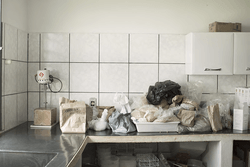research
Visiting Scholars 2007
S.M. Can Bilsel, University of San Diego, San Diego, United States Topic: The Modern Cult of Authenticity: Reproduction of Antiquity and the Location of Architecture in the 20th Century Museum Constance Classen, Concordia University, Montreal, Canada Topic: Beckford and Fonthill: Creating a Palace of the Senses Seminar: Multisensory Marketing and the Design of Retail(...)
May 2007 to September 2007
Visiting Scholars 2007
Actions:
Description:
S.M. Can Bilsel, University of San Diego, San Diego, United States Topic: The Modern Cult of Authenticity: Reproduction of Antiquity and the Location of Architecture in the 20th Century Museum Constance Classen, Concordia University, Montreal, Canada Topic: Beckford and Fonthill: Creating a Palace of the Senses Seminar: Multisensory Marketing and the Design of Retail(...)
research
May 2007 to
September 2007
Paul Nelson (1895–1979), American architect, film set designer, painter, critic, and educator, taught and practised architecture in the United States and France for over fifty years. Nelson was a central figure in the development of functionalism in the 1930s and 1940s, which rejected the Beaux-Arts language in favour of technological and functional expression. The Filter(...)
Main galleries
27 March 1991 to 26 May 1991
The Filter of Reason: The Work of Paul Nelson
Actions:
Description:
Paul Nelson (1895–1979), American architect, film set designer, painter, critic, and educator, taught and practised architecture in the United States and France for over fifty years. Nelson was a central figure in the development of functionalism in the 1930s and 1940s, which rejected the Beaux-Arts language in favour of technological and functional expression. The Filter(...)
Main galleries
research
Visiting Scholars 2002–2003
Chiara Baglione, IUAV-Istituto Universitario di Archittetura di Venezia, Venice, Italy Topic: Becoming an Architect in the Rome of Urban VIII: Architectural Training and Early Works of Pietro da Cortona Laurent Baridon, Université Marc Bloch, Strasbourg, France Topic: Dinocrate ou l’architecte en représentation Martin Bressani, McGill University, Montreal,(...)
5 January 2003 to 31 August 2003
Visiting Scholars 2002–2003
Actions:
Description:
Chiara Baglione, IUAV-Istituto Universitario di Archittetura di Venezia, Venice, Italy Topic: Becoming an Architect in the Rome of Urban VIII: Architectural Training and Early Works of Pietro da Cortona Laurent Baridon, Université Marc Bloch, Strasbourg, France Topic: Dinocrate ou l’architecte en représentation Martin Bressani, McGill University, Montreal,(...)
research
5 January 2003 to
31 August 2003
Money Matters: A Critical Look at Bank Architecture surveys the history and cultural significance of bank architecture, focusing on bank architecture as a building typology rather than in the context of a single architect or architectural firm. Challenging the standard notion that bank buildings are repetitive, dull and conservative, the exhibition reveals banks as(...)
Main galleries
14 November 1990 to 24 February 1991
Money Matters: A Critical Look at Bank Architecture
Actions:
Description:
Money Matters: A Critical Look at Bank Architecture surveys the history and cultural significance of bank architecture, focusing on bank architecture as a building typology rather than in the context of a single architect or architectural firm. Challenging the standard notion that bank buildings are repetitive, dull and conservative, the exhibition reveals banks as(...)
Main galleries
Learning from... Mumbai
Rahul Mehrotra presents a reading of Mumbai’s form as a symbol of India’s emerging urban culture. The lecture examines Mumbai, a megalopolis with more than 13 million inhabitants, as two distinct elements that occupy the same physical space. The first, the Static City, built of permanent materials like concrete, steel and brick, can be captured as a two-dimensional entity(...)
Paul Desmarais Theatre
9 April 2009
Learning from... Mumbai
Actions:
Description:
Rahul Mehrotra presents a reading of Mumbai’s form as a symbol of India’s emerging urban culture. The lecture examines Mumbai, a megalopolis with more than 13 million inhabitants, as two distinct elements that occupy the same physical space. The first, the Static City, built of permanent materials like concrete, steel and brick, can be captured as a two-dimensional entity(...)
Paul Desmarais Theatre
Disneyland, with its far-flung colonies in Florida, Japan, and France, is a key symbol of contemporary American culture that has been both celebrated and attacked as the ultimate embodiment of consumer society, of simulation and pastiche, of the blurring of distinctions between reality and mass-media imagery. The Architecture of Reassurance: Designing the Disney Theme(...)
Main galleries
17 June 1997 to 28 September 1997
The Architecture of Reassurance: Designing the Disney Theme Parks
Actions:
Description:
Disneyland, with its far-flung colonies in Florida, Japan, and France, is a key symbol of contemporary American culture that has been both celebrated and attacked as the ultimate embodiment of consumer society, of simulation and pastiche, of the blurring of distinctions between reality and mass-media imagery. The Architecture of Reassurance: Designing the Disney Theme(...)
Main galleries
Series
AP115.S1
Description:
Cette série porte sur le travail de documentation photographique de Robert Duchesnay d'un des exemples construit du Dymaxion Dwelling Machine, à Wichita, Kansas, aux États-Unis. Le Dymaxion Dwelling Machine, concept conçu par Buckminster Fuller et considéré comme le précurseur du dôme géodésique, visait a créer un mode d'habitation donnant un maximun d'espace pour un minimum de coût et de matériaux. L'exemple du Wichita House est conçu par Fuller en 1945-1946. "L'apparence de cette machine à habiter ressemble quelque peu à une soucoupe volante. Avec sa peau externe en aluminium et ses fenêtres en plexiglass, elle offre un surface élégante et profilée, tout en renferman un espace au sol de 1100 pieds carrées." [1] Le Dymaxion Dwelling Machine est abandonné en 1970, pour être finalement acquise en 1990 par le Henry Ford Museum à Detroit, au Michigan. La structure est démantelé la même année avec l'aide d'un ancien collaborateur de Buckminster Fuller, Jay Baldwin. Le Dymaxion Dwelling Machine est toujours visible au Ford Museum. La série contient des photographies de la Wichita House avant et durant le démantèlement, brochures et feuillets du Wichita Art Museum présentant l'exposition de Robert Duchesnay sur le bâtiment, correspondance reçue par Duchesnay sur son projet de documentation des dômes géodésiques de Buckminster Fuller, et coupures de presse sur le Dymaxion Dwelling Machine et le démantèlement de la Wichita House. [1] Robert Duchesnay, "Dymaxion Dwelling Machine", 2022, https://robertduchesnay.com/fr/dymaxion-fr/ (page consultée 27 février 2023).
1990-1992
Dymaxion Dwelling Machine, Wichita, Kansas
Actions:
AP115.S1
Description:
Cette série porte sur le travail de documentation photographique de Robert Duchesnay d'un des exemples construit du Dymaxion Dwelling Machine, à Wichita, Kansas, aux États-Unis. Le Dymaxion Dwelling Machine, concept conçu par Buckminster Fuller et considéré comme le précurseur du dôme géodésique, visait a créer un mode d'habitation donnant un maximun d'espace pour un minimum de coût et de matériaux. L'exemple du Wichita House est conçu par Fuller en 1945-1946. "L'apparence de cette machine à habiter ressemble quelque peu à une soucoupe volante. Avec sa peau externe en aluminium et ses fenêtres en plexiglass, elle offre un surface élégante et profilée, tout en renferman un espace au sol de 1100 pieds carrées." [1] Le Dymaxion Dwelling Machine est abandonné en 1970, pour être finalement acquise en 1990 par le Henry Ford Museum à Detroit, au Michigan. La structure est démantelé la même année avec l'aide d'un ancien collaborateur de Buckminster Fuller, Jay Baldwin. Le Dymaxion Dwelling Machine est toujours visible au Ford Museum. La série contient des photographies de la Wichita House avant et durant le démantèlement, brochures et feuillets du Wichita Art Museum présentant l'exposition de Robert Duchesnay sur le bâtiment, correspondance reçue par Duchesnay sur son projet de documentation des dômes géodésiques de Buckminster Fuller, et coupures de presse sur le Dymaxion Dwelling Machine et le démantèlement de la Wichita House. [1] Robert Duchesnay, "Dymaxion Dwelling Machine", 2022, https://robertduchesnay.com/fr/dymaxion-fr/ (page consultée 27 février 2023).
Série
1990-1992
This exhibition looks at the transformation of Montréal from a nineteenth century merchant city to the metropolis of Canada. It examines the elements that made Montréal a political, social, and economic centre and explores the unique character of its architecture. The exhibition brings together some 350 objects, including drawings from the CCA collection by Montréal(...)
Main galleries
18 March 1998 to 24 May 1998
Montréal Métropole, 1880–1930
Actions:
Description:
This exhibition looks at the transformation of Montréal from a nineteenth century merchant city to the metropolis of Canada. It examines the elements that made Montréal a political, social, and economic centre and explores the unique character of its architecture. The exhibition brings together some 350 objects, including drawings from the CCA collection by Montréal(...)
Main galleries
archives
Level of archival description:
Fonds
Pierlucio Pellissier fonds
AP215
Synopsis:
Le fonds Pierlucio Pellissier, 1946-2020, documente les projets de conservation et de commissariat entrepris par Pierlucio Pellissier, architecte, conservateur et professeur, entre 1996 et 2003. Le fonds comprend des documents textuels et photographiques touchant à trois projets distincts : les restaurations de deux églises décorées par l’architecte et artiste Guido Nincheri (1885-1973), qui en assura également le design architectural, soit Sainte-Amélie à Baie-Comeau, Québec (1938-1939) et Notre-Dame-de-la-Défense, Montréal (1919), et le commissariat d’une exposition sur l’œuvre de Guido Nincheri tenue à Montréal en 2001. Le travail de conservation et de restauration des fresques de Nincheri, qui ornent les deux églises, forme la plus grande partie de la documentation, mettant en lumière la spécificité du médium et les problématiques de la conservation d’œuvres d’art à portée publique.
1946-2020
Pierlucio Pellissier fonds
Actions:
AP215
Synopsis:
Le fonds Pierlucio Pellissier, 1946-2020, documente les projets de conservation et de commissariat entrepris par Pierlucio Pellissier, architecte, conservateur et professeur, entre 1996 et 2003. Le fonds comprend des documents textuels et photographiques touchant à trois projets distincts : les restaurations de deux églises décorées par l’architecte et artiste Guido Nincheri (1885-1973), qui en assura également le design architectural, soit Sainte-Amélie à Baie-Comeau, Québec (1938-1939) et Notre-Dame-de-la-Défense, Montréal (1919), et le commissariat d’une exposition sur l’œuvre de Guido Nincheri tenue à Montréal en 2001. Le travail de conservation et de restauration des fresques de Nincheri, qui ornent les deux églises, forme la plus grande partie de la documentation, mettant en lumière la spécificité du médium et les problématiques de la conservation d’œuvres d’art à portée publique.
archives
Level of archival description:
Fonds
1946-2020
As the Earth’s climate reaches a state of constant instability, there is growing awareness of how global warming can affect human rights and increase social strife. Less attention has been paid to the ways in which political violence and human rights abuses, from past and present, constitute driving factors in the transformations of the global environment and climate.(...)
Paul Demarais Theatre
1 December 2016, 6pm
In the Frontiers of Climate Change (Toward a Politics of Nonhuman Rights)
Actions:
Description:
As the Earth’s climate reaches a state of constant instability, there is growing awareness of how global warming can affect human rights and increase social strife. Less attention has been paid to the ways in which political violence and human rights abuses, from past and present, constitute driving factors in the transformations of the global environment and climate.(...)
Paul Demarais Theatre





